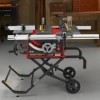Craftsman 21829 Operation Manual - Page 4
Inspect Tool Cords Periodically. If Damaged - parts
 |
View all Craftsman 21829 manuals
Add to My Manuals
Save this manual to your list of manuals |
Page 4 highlights
work or around or over the blade while blade is rotating. Do not attempt to remove cut material when blade is moving. • BLADE COASTS AFTER BEING TURNED OFF, • NEVER USE IN AN EXPLOSIVE ATMOSPHERE. Normal sparking of the motor Gould ignite fumes. • INSPECT TOOL CORDS PERIODICALLY. If damaged, have repaired by a qualified service technicianat an authorizedservice facility.The conductorwith insulationhaving an outer surfase that is green with or without yellow sl:ipes is the equipment-ground[ng conductor.If repair or replacement of the electric cord or plug is necessary,do not connect the equipment-grounding conductor to a live terminal.Repair or replace a damaged or worn cord immediately.Stay constant_j aware of cord location and keep itwen away from the rotatingblade. • INSPECT EXTENSION CORDS PERIODICALLY and replace if damaged. • GROUND ALL TOOLS. if tool is equipped with three- prong plug, it should be plugged into a thrse-ho_e electrical race,oracle. • CHECKWlTH A QUALIFIED ELECTRICIAN or service personnelif the 9rounding instructionsare not completely understoodor if in doubt as to whether the tool is properly 9rounded. • USE ONLY CORRECT ELECTRICAL DEVICES: 3-wira e0_.tansiocnords that have 3-prong groundingplugs and 3-pole receptaclesthat accept the tool's plug. • DO NOT MODIFYthe plug provided. If it will not fit the outlet, have the proper outlet installed by a quatified etectndan. • KEEP TOOL DRY, CLEAN, AND FREE FROM OIL AND GREASE. Always use a c_eancloth when clean- ing. Never use brake fluids, gasoline,pe_'oleum-based products, or any soWantsto clean tool. • STAY ALERT AND EXERCISE CONTROL. Watch what you are doing and use common sense. Do not operate tool when you are tired. Do not rush. • DO NOT USE TOOL IFSWlTCH DOES NOT TURN IT ON AND OFF. Have defective switchesreplaced by an authorizedservtce center. • USE ONLY CORRECT BLADES. Do not use blades with incorrect size holes. Never use blade washers or blade bo{Lsthat ere defective or incorrect.The maxi- mum blade capacity of your saw is 10 in. {254 ram). • BEFORE MAKING A CUT, BE SURE ALL ADJUST- MENTS ARE SECURE. • BE SURE BLADE PATH IS FREE OF NAILS. inspect for and remove all nails from lumber before cutting. • NEVER TOUCH BLADE or other moving parts during USe. • NEVER START A TOOL WNEN ANY ROTATING COMPONENT IS IN CONTACT WITH THE WORKPIECE. • DO NOT OPERATE A TOOL WHILE UNDER THE INFLUENCE OF DRUGS, ALCOHOL, OR ANY MEDICATION. • WHEN SERVICING use only identica]replacement parts. Use of any other parts may create a hazard or cause product damage. • USE ONLY RECOMMENDED ACCESSORIES listed in this manual or addendums. Use of accessories that are not listed may cause the risk of personal injury. Instructions for safe use of aecsseorias are Inciuded with the accessory. • DOUBLE CHECK ALL SETUPS. Make sure blade is tight and not trek(rig contact with saw or workpieca before connecting to power supply. • GUARD AGAINST KICKBACK. Kickback occurs when the blade stalls rapidly and workplace is driven beck tow_ds the o_arator. It can pull your h_nd (nto the blade resultingin serious personalinjury.Stay out oi blade path and turn switch off immedi_ely if blade bindsors_iis, • USE RIP FENCE. Always use a fence or straight edge guidewhen Hpping. • SUPPORT LARGE PANELS. To minimize risk of blade pinchingand kickback, always support large panels. • REMOVE ALL RENCES AND AUXILIARY TABLES before transpo_ng saw. Failureto do so can result in an accidsn.tcausing pose_le serious personalinjury. • ALWAYS USE BLADE GUARD, RMNG KNIFE/ SPREADEPJSPLrl-rER, AND ANTI-KICKBACK PAWLS on 81[=through-sawing =operations. Through- sawing operations are those Inwhich the blade outs completely through the work.pieceas in rippingor crass out_r,g. Keep the b_de gu_-d down, th_ _ntikickback pawls down, and the rivingkrdfe/spreader/ splitter properly alignedto '_e saw blade. • ALWAYS ,RECURF.WORK firmly against rip fence, miter fence, or miter gauge. • ALWAYS USE A PUSH STICK FOR RIPPING NAR- ROW STOCK. A push stick is a device used to push a workplace through the blade instead of using your hands. Size and shape canvary but the pushstick must always be narrowerthan the workp, iece to prevent the push stick from contacting th_ saw blade. When ripping narrowstock, always usaa pushstick,so yourhand does not come closeto ths sew blade. Use a fea_herbeard and push blocks for non-throughouts. 4













